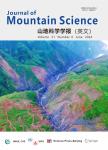Modelling spatial variation in the treatment costs of nonpoint source pollution in mountainous regions of southwest China
Modelling spatial variation in the treatment costs of nonpoint source pollution in mountainous regions of southwest China作者机构:Key Laboratory of Environment Change and Resources Use in Beibu Gulf(Ministry of Education)Key Laboratory of Earth Surface Process and Intelligent SimulationNanning Normal UniversityNanning 530001China Institute of Mountain Hazards and EnvironmentChinese Academy of SciencesChengdu 610041China
出 版 物:《Journal of Mountain Science》 (山地科学学报(英文))
年 卷 期:2019年第16卷第8期
页 面:1901-1912页
核心收录:
基 金:sponsored by National Natural Science Foundation of China (Grant Nos. 41371539) Guangxi Natural Science Foundation Program (Grant Nos. 2018GXNSFBA138026) Guangxi Young and Middle-aged University Teachers’ Scientific Research Ability Enhancement Project (Grant Nos. 2018KY0360)
主 题:Nonpoint source pollution Water treatment cost Water purification model InVEST Tool Export coefficient Spatial variation
摘 要:Non-point source(NPS) pollution is considered to be one of the main threats of the aquatic environment. Mountainous regions are particularly important water sources for urban areas. The various driving factors of NPS pollution such as terrain, precipitation, and vegetation type in mountainous regions show clear spatial heterogeneity. Consequently, the management systems required for NPS pollution in mountainous regions are complex. In this study, we developed a framework to estimate and map the treatment costs for NPS pollution in mountainous regions and applied this method in Baoxing County, a typical mountainous county in Sichuan Province of southwest China. The export levels of total nitrogen(TN) and total phosphorus(TP) in Baoxing County were estimated using the water purification model in InVEST(Itegrated Valuation of Ecosystem Services and Tradeoffs) tool. NPS pollutant treatment costs were calculated based on the level of pollutants exports, water yield, water quality targets, and treatment costs of NPS pollutants per unit mass. The results show that at the watershed level the amounts of TN and TP exported in Baoxing County were below threshold limits. However, at the sub-watershed level, TN and TP excesses of 291.64 and 2.96 tons per year were found, respectively, with mean TN and TP treatment costs of 6.58 US$/hm^2 and 0.35 US$/hm^2. Appraising pollution treatment cost intuitively reflects the overall expenditure in NPS pollution reduction from an economic perspective. This study provides a foundation for the implementation of Payment for Ecosystem Service(PES) and the prevention and control of NPS pollution.



